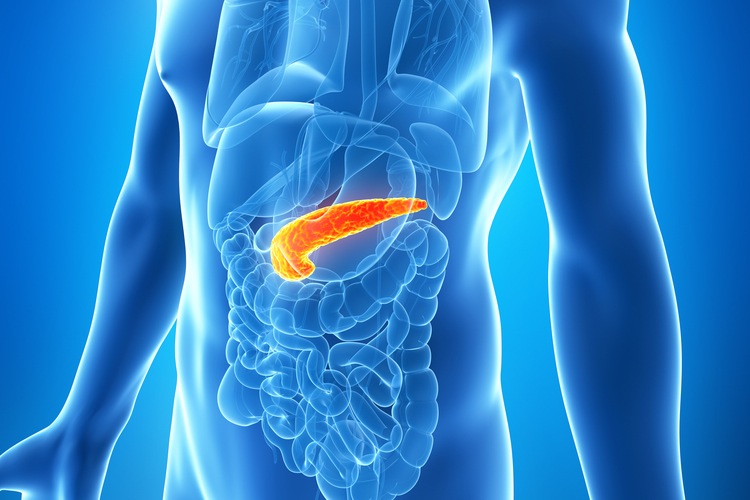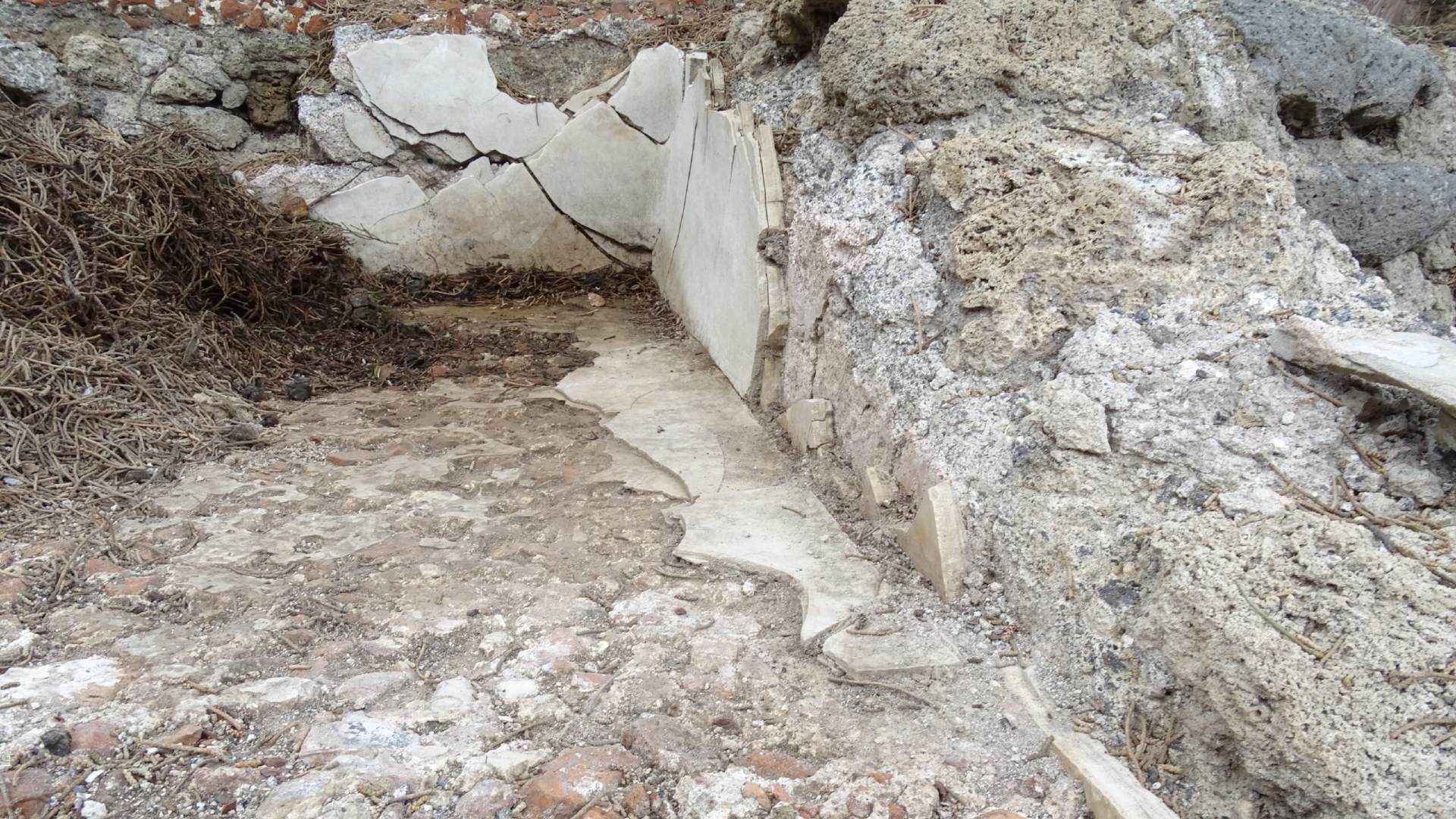Pancreas: Function, Location & Diseases

The pancreas is an abdominal organ that is located behind the stomach and is surrounded by other organs, including the spleen, liver and small intestine. The pancreas is about 6 inches (15.24 centimeters) long, oblong and flat.
The pancreas plays an important role in digestion and in regulating blood sugar. Three diseases associated with the pancreas are pancreatitis, pancreatic cancer and diabetes.
Function of the pancreas
The pancreas serves two primary functions, according to Jordan Knowlton, an advanced registered nurse practitioner at the University of Florida Health Shands Hospital. It makes "enzymes to digest proteins, fats, and carbs in the intestines" and produces the hormones insulin and glucagon, he said.
Dr. Richard Bowen of Colorado State University's Department of Biomedical Sciences wrote in Hypertexts for Pathophysiology: Endocrine System, "A well-known effect of insulin is to decrease the concentration of glucose in blood." This lowers blood sugar levels and allows the body's cells to use glucose for energy.
Insulin also allows glucose to enter muscle and other tissue, works with the liver to store glucose and synthesize fatty acids, and "stimulates the uptake of amino acids," according to Bowen. Insulin is released after eating protein and especially after eating carbohydrates, which increase glucose levels in the blood. If the pancreas does not produce sufficient insulin, type 1 diabetes will develop.
Unlike insulin, glucagon raises blood sugar levels. According to the Johns Hopkins University Sol Goldman Pancreatic Cancer Research Center, the combination of insulin and glucagon maintains the proper level of sugar in the blood.
The pancreas' second, exocrine function is to produce and release digestive fluids. After food enters the stomach, digestive enzymes called pancreatic juice travel through several small ducts to the main pancreatic duct and then to the bile duct, according to the Medical University of South Carolina’s Digestive Disease Center. The bile duct takes the juice to the gallbladder, where it mixes with bile to aid in digestion.
Get the world’s most fascinating discoveries delivered straight to your inbox.
Location of the pancreas
"The pancreas is located in the upper abdomen behind the stomach," Knowlton said. The right end of the pancreas is wide and called the head. From the head, the organ tapers to the left. The middle sections are called the neck and body, while the narrow end on the left side of the body is called the tail.
The Hume-Lee Transplant Center at Virginia Commonwealth University described the pancreas as "j-shaped." The portion of the pancreas called the uncinate process bends backward from the head and underneath the body, according to the Pancreatic Cancer Action Network.
Pancreas pain
Intense pancreatic pain is usually associated with acute pancreatitis. It can be hard to identify pancreas pain and evaluate pancreas diseases because the organ sits deep in the abdomen, according to The National Pancreas Association. Other signs that the pain may be pancreatic include jaundice, itchy skin and unexplained weight loss. If you are experiencing pancreas pain, consult your doctor.
Pancreatitis
The National Institutes of Health defines pancreatitis as inflammation of the pancreas, happening when "digestive enzymes start digesting the pancreas itself." It can be acute or chronic, but both forms should be taken seriously and may lead to additional health problems.
Chronic pancreatitis
There are up to 23 cases of chronic pancreatitis per 100,000 people per year worldwide. In just the United States, it results in more than 122,000 outpatient visits and more than 56,000 hospitalizations per year, according to the Cleveland Clinic.
"Chronic pancreatitis is a persistent inflammation (greater than three weeks) of the pancreas that causes permanent damage," Knowlton said. The condition is often caused by "heavy, ongoing" alcohol consumption, but she added that there are other causes, including "those that cause acute pancreatitis attacks." Other causes may be cystic fibrosis, high levels of calcium or fat in the blood and autoimmune disorders.
Symptoms include upper abdominal pain, nausea, vomiting, weight loss, and oily stools. According to Peter Lee and Tyler Stevens, in an article for the Cleveland Clinic, "clinically apparent" oily stools (steatorrhea) do not appear until "90 percent of pancreatic function has been lost."
"Chronic pancreatitis requires dietary modifications, including a low-fat diet and cessation of alcohol [intake] and smoking," Knowlton said. Chronic pancreatitis does not heal and tends to worsen with time, and "treatment options are mostly for pain relief." She added that treatments "may include a pancreas stent or, for severe cases, surgery (either a lateral pancreaticojejunostomy, or a Whipple procedure)." Pancreatiocojejunostomies are designed to decrease pancreatic leakage while the Whipple procedure removes the head of the pancreas where, according to the Mayo Clinic, most tumors occur.
There may be a link between chronic pancreatitis and pancreatic cancer. According to the University of California Los Angeles Center for Pancreatic Diseases, "Recent studies reveal a 2-5 times increase in the incidence of pancreatic cancer in patients with chronic pancreatitis from a variety of causes."
Acute pancreatitis
"Acute pancreatitis is inflammation of the pancreas (lasting less than three weeks), that is most often caused by gallstones," said Knowlton. It usually comes on suddenly and disappears within a few days of treatment. In addition to gallstones, Knowlton said that causes "may include medications, high triglycerides, high calcium in the blood and high alcohol consumption."
Pancreas pain is the chief symptom of acute pancreatitis, according to Medscape. The pain is usually severe and sudden. It increases in severity until it becomes a constant ache. This pancreas pain is felt in the upper abdomen. The Mayo Clinic noted that the pain can radiate through to the back, and Knowlton pointed out that it might be worse after eating. Other symptoms of acute pancreatitis include nausea, vomiting, fever and diarrhea.
According to Knowlton, "This patient often looks acutely ill, and requires hospitalization (typically for three to five days), intravenous (IV) hydration, nothing by mouth (for bowel rest), pain medication, treatment of underlying conditions, and possibly a radiologic procedure called an endoscopic retrograde cholangiopancreatography (ERCP), which can more specifically target the problem." If the acute pancreatitis was caused by gallstones, doctors may recommend removing the gallbladder.
Pancreatic cancer
It is hard to diagnose pancreatic cancer early. The Mayo Clinic noted that symptoms typically don't occur until the cancer has advanced. Knowlton said, "Unfortunately, symptoms can be vague, but can include abdominal pain, jaundice, severe itching, weight-loss, nausea, vomiting, and digestive problems."
Making matters even more complicated is the pancreas' deep-in-the-abdomen location. The NIH pointed out that as a result, tumors cannot usually be felt by touch. Because of the difficulty of early diagnosis and the rapidity with which pancreatic cancer spreads, the prognosis is often poor.
Risk factors for pancreatic cancer include smoking, long-term diabetes and chronic pancreatitis, according to the National Cancer Institute.
According to the American Cancer Society, pancreatic cancer usually begins in the cells that produce pancreatic (digestive) juices or in the cells that line the ducts. In rare occasions, pancreatic cancer will begin in the cells that produce hormones.
According to the University of Texas MD Anderson Cancer Center, to diagnose pancreatic cancer, doctors typically conduct physical exams, blood tests, imaging tests, endoscopic ultrasounds and tests and biopsies. Treatment options include surgery, radiation, chemotherapy and therapies targeted to attack cancer cells without harming normal cells.
Artificial pancreas
When a person's pancreas isn't functioning properly or has to be removed, doctors may replace or supplement it with an artificial pancreas. These devices that automatically monitor blood glucose and provide the appropriate insulin doses are often called closed-loop systems, automated insulin delivery systems, or autonomous systems for glycemic control, according to the Food and Drug Administration.
In a 2014 study published in the journal The Lancet Diabetes & Endocrinology, researchers found that an artificial pancreas offer people with type 1 diabetes a reliable way to keep glucose levels in check, when compared to other treatments. "Our study confirms that both artificial pancreas systems improve glucose control and reduce the risk of hypoglycemia compared to conventional pump therapy," study author Ahmad Haidar, of Institut de Recherches Cliniques de Montreal, said in a statement. [Artificial Pancreas May Improve Type 1 Diabetes Treatment]
Additional reporting by Alina Bradford, Live Science contributor.
Additional resources
- National Pancreas Foundation: About the Pancreas
- The Pancreas Center at Columbia University: The Pancreas and Its Functions
- Cleveland Clinic: Chronic Pancreatitis
Related pages about the human body
Parts of the human body
- Bladder: Facts, Function & Disease
- Human Brain: Facts, Anatomy & Mapping Project
- Colon (Large Intestine): Facts, Function & Diseases
- Ears: Facts, Function & Disease
- Esophagus: facts, Function & Diseases
- How the Human Eye Works
- Human Heart: Anatomy, Function & Facts
- Kidneys: Facts, Function & Diseases
- Liver: Function, Failure & Disease
- Lungs: Facts, Function & Diseases
- Nose: Facts, Function & Diseases
- Pancreas: Function, Location & Diseases
- Small Intestine: Function, Length & Problems
- Spleen: Function, Location & Problems
- Stomach: Facts, Function & Diseases
- The Tongue: Facts, Function & Diseases
Systems of the human body
- Circulatory System: Facts, Function & Diseases
- Digestive System: Facts, Function & Diseases
- Endocrine System: Facts, Functions and Diseases
- Immune System: Diseases, Disorders & Function
- Lymphatic System: Facts, Functions & Diseases
- Muscular System: Facts, Functions & Diseases
- Nervous System: Facts, Function & Diseases
- Reproductive System: Facts, Functions and Diseases
- Respiratory System: Facts, Function & Diseases
- Skeletal System: Facts, Function & Diseases
- Skin: Facts, Diseases & Conditions
- Urinary System: Facts, Functions & Diseases
Jessie Szalay is a contributing writer to FSR Magazine. Prior to writing for Live Science, she was an editor at Living Social. She holds an MFA in nonfiction writing from George Mason University and a bachelor's degree in sociology from Kenyon College.
 Live Science Plus
Live Science Plus





